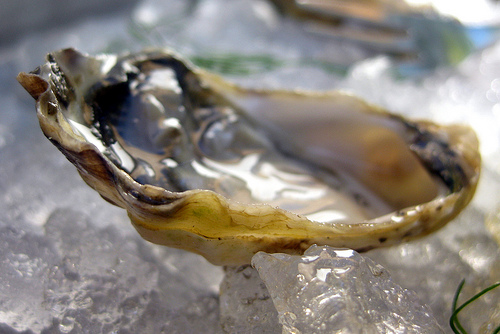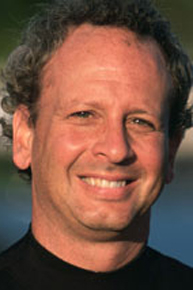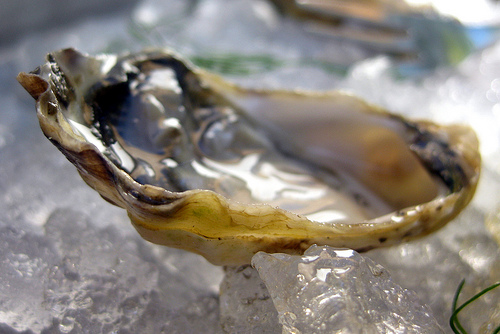 Consider the oyster — carefully. Photo: Wally GobetzCross-posted from Cool Green Science.
Consider the oyster — carefully. Photo: Wally GobetzCross-posted from Cool Green Science.
The headlines were enough to make you throw away your shucking knife: “More than 85 percent of [oyster] reefs have been lost due to overfishing, according to a new study,” said The Independent. Foodie bloggers panicked over the news — was it suddenly an eco-crime to belly up to the oyster bar? Would oyster eating be forced underground, like those little birds the French eat with napkins over their faces? Could you ever again enjoy shelling out for these delicious bivalves with a clear conscience?
Yes, you should eat oysters, says the lead author of that study — just make sure you order the right kinds. Mike Beck, lead marine scientist with The Nature Conservancy, has been studying shellfish (and eating them) most of his adult life. While his research does say that oyster reefs are the habitat most impacted by human activity, Beck hastens to add that there are plenty of oysters on the market that are raised sustainably. I asked Beck to guide us through the confusion — and to talk about which varieties he prefers to slurp down.
Q. Let’s set the record straight: Should we keep eating oysters, or stop? What’s your research actually telling you?
A. First to be clear, our research in the Bioscience paper (“Oyster Reefs at Risk“) did not address at all whether or not you should eat oysters. We did address the loss of wild oyster reefs around the globe; what has been (and is still) happening to decimate them and how we can reverse that with some sensible and cost-effective conservation, restoration, and management.
These days the oysters on your plate are more than likely to come from an aquaculture farm. Shellfish farms represent one of most — if not the most — sustainable forms of aquaculture and fish production.
Q. Should I ever eat a wild oyster? How would I know I’m not adding to the problem if I do?
A. There are not that many places left where wild oysters are sustainably harvested. Our research showed that there are a few bays, particularly in the Gulf of Mexico, where oyster and oyster reefs are still doing well. But they are still declining in most bays, even in the Gulf.
It’s actually a real shame that, around the globe, we found that most states and countries are still trying to harvest wild oysters. They’re doing so even with their reefs at less than 10 percent of their former abundance. In many places, there is still harvesting after 99 percent of the original reef had been lost. Simply put, that’s bad fishery management.
 Shell game: scientist Mike Beck.Q. OK, then what kind of oysters can we feel good about eating, given that 86 percent of oyster reefs globally are now lost?
Shell game: scientist Mike Beck.Q. OK, then what kind of oysters can we feel good about eating, given that 86 percent of oyster reefs globally are now lost?
A. In most cases, you should feel good about eating oysters raised in aquaculture. You can feel really good about eating oysters raised near or in your local bay, because then you’re supporting your local shellfish farmers (which are mostly small operators). And you can feel great if you are eating native shellfish from your local farm (such as eastern oysters on the East Coast).
Indeed, in terms of reviving native reefs, we find in our paper that aquaculture is a big part of the solution.
Q. Are you saying that eating oysters grown by aquaculture actually takes the pressure off wild oyster reefs?
A. Yes. Aquaculture is beneficial for numerous reasons. First, it can indeed reduce pressure on wild reefs (if it’s coupled with better regulation of the wild fishery). For those farms raising native oysters, they often are a great supporter of native reef restoration efforts, because oysters on those restored reefs can reproduce and help to increase the supply of required seed oysters at a commercial scale. Lastly, shellfish farmers and oyster restoration practitioners both want clean water for their oysters, and so the two goals are perfectly aligned.
Like any business, even shellfish aquaculture does have impacts to the environment (and in the past had more). But shellfish farmers these days are generally very conscientious and professional. The one thing we do caution against in the paper is the further spread of non-native oyster species (and the invasive hitchhikers that can come with them). The decade-long debate about introducing an Asian oyster species to the Chesapeake Bay was recently settled in favor of native oysters, but this tendency to replace native species with non-native species remains a problem globally.
Q. Aquaculture often gets a bad rap as a polluter. What is it about oyster aquaculture practice that in your judgment makes it so sustainable?
A. Well, the biggest benefit is that shellfish farms do not require artificial feed; oysters filter their food (microscopic algae) naturally from the bay. This lowers the cost for everyone and reduces all the impacts and waste that come with most fish farms, which take more fish (as feed) than they grow.
Q. Last year you coauthored an op-ed in The New York Times entitled “Where Oysters Grew on Trees,” about how oyster reefs used to dominate the Gulf of Mexico and other U.S. bays like coral reefs do in the tropics — “condominiums of the sea,” you called them. But coral reefs are hanging on, while 86 percent of the planet’s original oyster reefs have been decimated. Why the disparity in survival? Are they really fragile?
A. Coral reefs are not doing great, either, but they have at least fared better till now than oyster reefs. And no — it’s not because oyster reefs are fragile. They are actually incredibly resilient when you give them half a chance. The biggest problems are that we have forgotten how majestic oyster reefs used to be and that we manage to try and get every last oyster.
Q. There are a lot of agencies and groups including The Nature Conservancy that are now heavily involved in oyster reef restoration in the Gulf of Mexico, Chesapeake Bay, and other places. How long does it take to restore a reef? What’s involved?
A. It’s much quicker to grow a reef than, say, a forest. Oysters grow quickly, often becoming adults in 18 months to 3 years, and most species produce hundreds of thousands of young.
One of the main approaches that we use is to create a reef base (with oyster or clam shells or, when necessary, oyster-lime cement or other artificial material). Once you have the base of the reef, this provides a huge jump-start for new oysters to settle on. It raises them off the bottom and gets them up in water where there is more oxygen, more food and less sediment (dirt) to smother them. This helps create the same natural environment that oysters most favor and grow best in. Do this right and you can get new, living reefs in 2-5 years.
Of course, the temptation is always to harvest all the oysters as soon as they start coming back. It would be impossible to restore a marsh if I dug up the plants every other year, but for some reason we think we can do that with oysters. Ultimately, this practice overlooks the larger goal of restoring the oyster reef COMMUNITY — the other organisms that live on, in and around intact oyster reefs that provide them with the structure they require to grow and reproduce. This can take a bit more time, but it seems likely that ‘if we build it’ the other organisms will come.
Q. But why restore them if we’re not going to harvest from them? What are the benefits?
A. We actually do think you can harvest oysters from bays where there is a sufficient acreage of restored reefs that are providing a full range of benefits, including fish habitat and clean water. It just makes good business sense to invest and build natural capital (reefs) and then harvest the interest from nearby harvest areas, and leave the principle untouched for future years.
Q. Final question: Where do the oysters you eat come from? And how do you like ’em served?
A. Because I was born and raised along Long Island Sound, Chesapeake Bay, and the Gulf of Mexico, I have a real preference for the eastern oyster. I eat the most when I’m back down in the Gulf; I like a half dozen raw and half dozen bbq’ed on an open flame.



